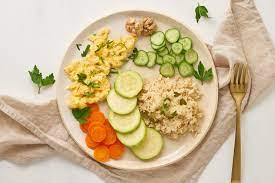IBS impacts millions globally. The low-FODMAP diet can ease IBS symptoms. Few people with IBS experience bad symptoms. Some people can manage their symptoms by watching what they eat, how they live, and how much stress they have. Medication and counseling can help with the more severe symptoms.
Many people find relief from the symptoms of IBS by following a low-FODMAP diet. By avoiding foods high in FODMAPs, many people find comfort from IBS symptoms. A low-FODMAP diet can be a great way to reduce digestive discomfort and manage IBS symptoms.
We hope that by the end of this article, you will better understand how to follow a low-FODMAP diet.
Table of Contents
The FODMAP Diet: Eating Low-FODMAP Meals for IBS Relief
The low-FODMAP diet can help manage IBS symptoms. IBS affects the gastrointestinal system, which includes the stomach and intestines. There may be cramping, abdominal pain, bloating, gas, diarrhea or constipation, or both. IBS is a long-term condition that you’ll have to take care of for a long time.
Low-FODMAP meal delivery is the best option for easy, healthy, and delicious meals. FODMAP meal delivery assures everyone may find a good and nutritious meal. It also makes eating healthy easy with prepared meals delivered to your door. And it is easier to follow your diet with various flavors and options.
People with irritable bowel syndrome often feel better on a low-FODMAP diet. This diet can help reduce symptoms like gas, discomfort, and diarrhea. It lowers the number of fermentable carbs you eat. And to ensure that you get a meal fit for your LFD, FODMAP meal delivery might be the answer!
What to Eat
In a regular diet, the total amount of FODMAPs you eat daily is between 15 and 30 grams. Limiting lactose, gluten, certain vegetables, and grains can treat IBS.
But an LFD (Low-FODMAP Diet) is not a diet without gluten and lactose. Its global impact is more significant than that of a diet restriction. A single fruit may not bring back IBS symptoms, but eating bread, half an onion, a pear, and milk may.
The low-FODMAP diet is not a “diet of avoidance.” It can also be used as a diagnostic technique to see if a person can handle certain meals. If they can’t, they can cut them out of their diet and make other significant changes to their lives.
You can have oatmeal with almond milk or a low-FODMAP smoothie for breakfast. For lunch, you can make a salad with quinoa, cucumber, and tomatoes. For dinner, try a low-FODMAP stir-fry with zucchini, mushrooms, and bell peppers. Plenty of low-FODMAP desserts will satisfy your sweet tooth.
When following a low-FODMAP diet, planning, and preparation are essential. Meal prep is vital to ensuring you always have healthy, low-FODMAP meals. Start by making a low-FODMAP grocery list. Then stock your kitchen with the necessary ingredients. You can also make several meals beforehand, so you don’t have to worry about cooking every night.
Omitting FODMAPs from your diet can be an effective way to manage your IBS symptoms. Planning and preparing low-FODMAP meals and snacks can make it easier to stick to your diet.
What to Avoid Eating
While there is no cure for IBS, certain foods and medications can worsen symptoms. Avoiding the following foods may bring some relief:
-
Milk
People who can’t handle lactose can have gas and bloating from milk and other lactose-containing foods.
-
Foods High in Fructose
Processed foods, snacks, and drinks include high fructose corn syrup. They may increase IBS symptoms. But they are not the only ones to blame (or make the problem worse).
Apples, pears, and dried fruits are high in fructose. When eaten, they can cause some of the same adverse effects. People with IBS may do better on berries, citrus, and bananas, which have less sugar than other fruits.
-
Carbonated Beverages
Water or lactose-free milk can quench your thirst. Soda and seltzer bubbles can fizz your GI system. And before you add juice to that list, know that drinks made from fruit sometimes have a lot of fructose.
-
Caffeine
Diarrhea is another common symptom of IBS, and caffeine can make it worse. Coffee, tea, cola drinks, chocolate, and several over-the-counter headache medications have caffeine. Read the labels to find out which ones.
-
Sugar-free Chewing Gums
Artificial sweeteners created by many sugar-free gums can cause diarrhea. Also, chewing gum makes you swallow more air and feel gassy.
Other foods that can worsen IBS symptoms include beans, broccoli, Brussels sprouts, and weight-loss supplements.
Tips for Following the Low-FODMAP Diet
-
Know Your Trigger Foods
Have you ever eaten a box of cookies or a pint of ice cream alone? High-calorie foods can make you overdo and overeat.
Lena Beal, M.S., RD, LD, a Piedmont’s Fuqua Heart Center therapeutic dietitian, says the most common trigger foods are tasty foods high in sugar, salt, and bad fats. “This includes sodas, chips, cakes, cookies, and pies. If you eat a lot, you’ll want more.
Beal recommends the following ways to avoid overeating:
- Drink a glass of water before your meal since it makes you feel full.
- Consume a well-balanced meal with lean protein, whole grain starch, fruit, and vegetables. And consume them in that sequence. Start with fruits and vegetables. Then starch and protein after if you’re still hungry.
- Eat. Make sure you eat at the same time and amount every day.
- If you want something, eat it. Yet, do so in a healthy manner. Get some chips with your lunch if you’re craving them. And combine it with something more nutritious, like a salad.
- Keep granola or trail mix in your desk drawer to have healthier options.
-
Learn How to Read Food Labels
As a customer, you must make intelligent decisions about the food you buy. This is why there are signs on food. They give us the information we need to make good choices about our health and nutrition. When we know how to read food labels, we get more for our money and are protected from false claims on the packages.
-
Make a Meal Plan
- PART CONTROL
Planning meals lets you see how much you eat. This protects you from overeating at restaurants, which usually provide too much.
- EAT WELL
When you’re hungry, you will definitely eat whatever’s closest. Some of us choose the nearest unhealthy fast-food restaurant. When a balanced, nutrient-dense meal is ready, meal planning solves this problem!
- SAVE TIME
Being hungry and unprepared is stressful. Instead of staring at your fridge or cupboard, you can make a healthy supper in minutes. This eliminates cooking cleanup.
- SAVE CASH
Meal planning helps save money, something we all want to do. Meal preparation saves money by shopping in bulk and avoiding restaurants. Sticking to the list prevents grocery store impulse buys.
- SAVE FOOD
Meal preparation requires a grocery list and a plan. Having a purpose for every food item in your fridge prevents waste.
Planning your week’s meals is worth it, whether you’re cooking for a family or yourself. Set aside a little time each week.
“Take one meal at a time,” says Veri. Choose the most fabulous dinner!”
-
Experiment with Substitutes
Substitution can save you when you don’t have an item a recipe calls for, but it can also make a recipe better for you. That’s helpful if you’re trying to change how you eat or cook for a health issue.
Conclusion
Following the low-FODMAP diet can be a great way to reduce digestive symptoms and improve health. Keep track of which foods are low and high in FODMAPs and which are tolerable in moderation. It can also be helpful to consult with a dietitian or nutritionist. They can help an individual make a plan that fits his or her wants and tastes.
Remember that following the low-FODMAP diet is not an easy process. It may take some time to adjust and find the right balance.
















